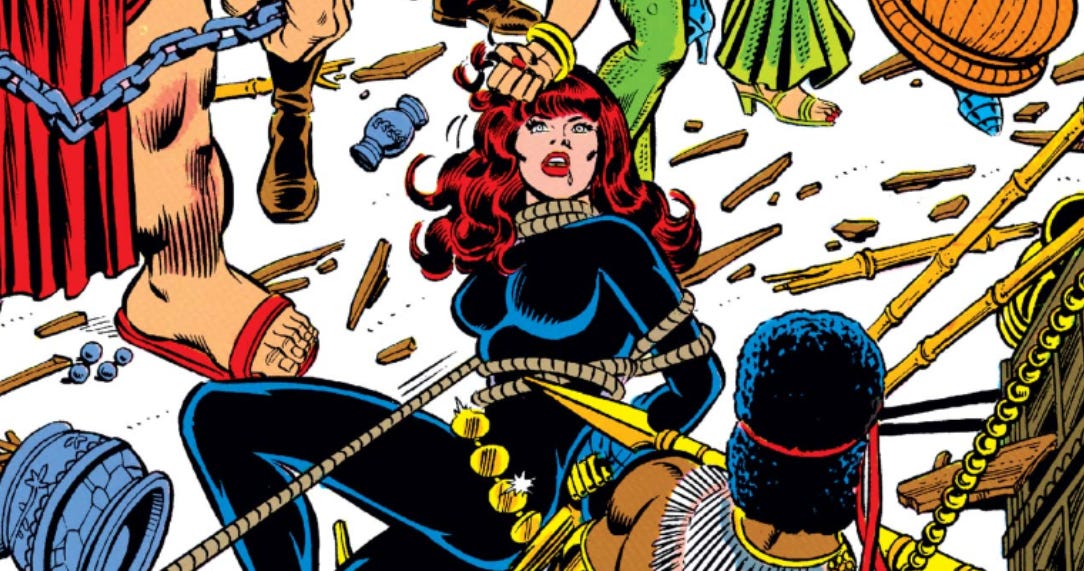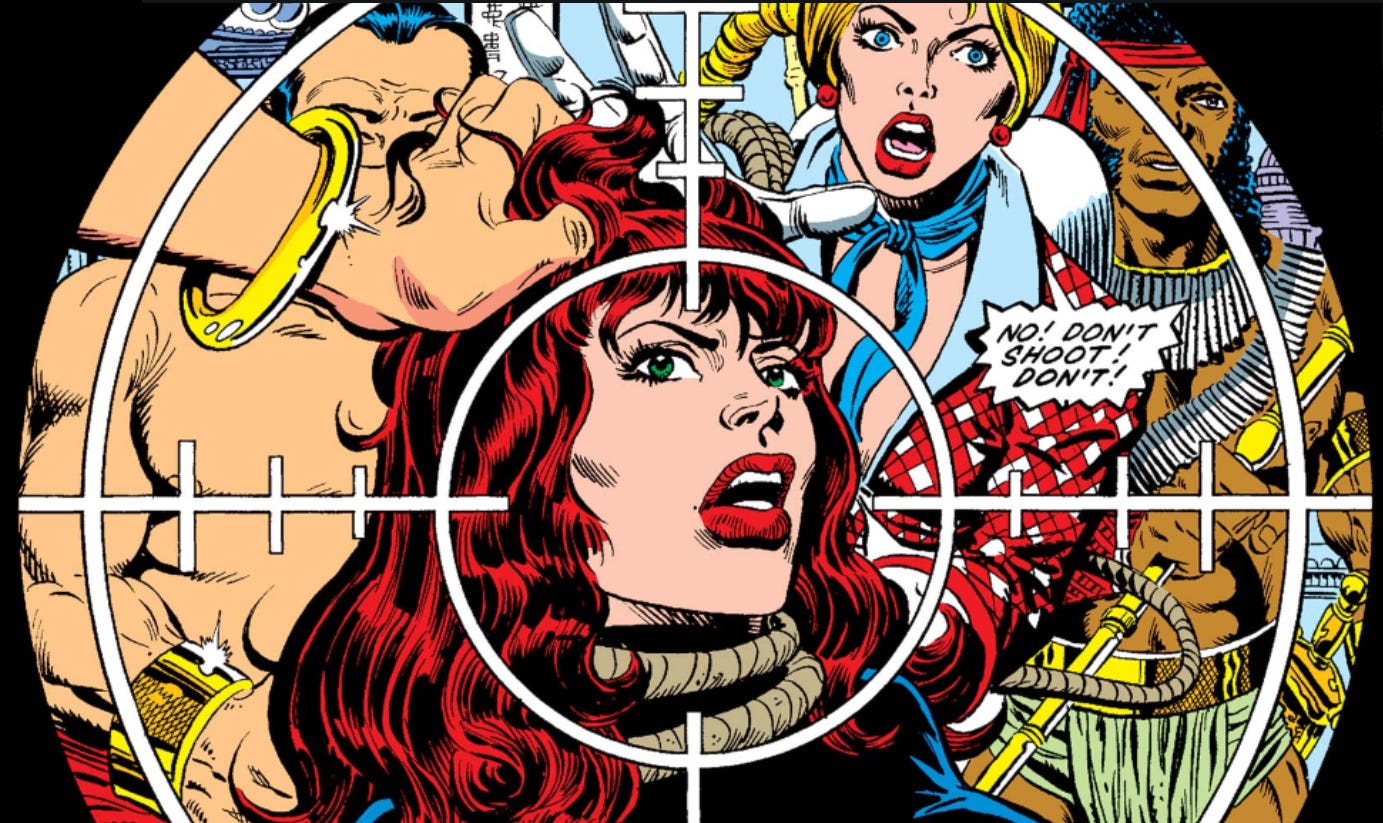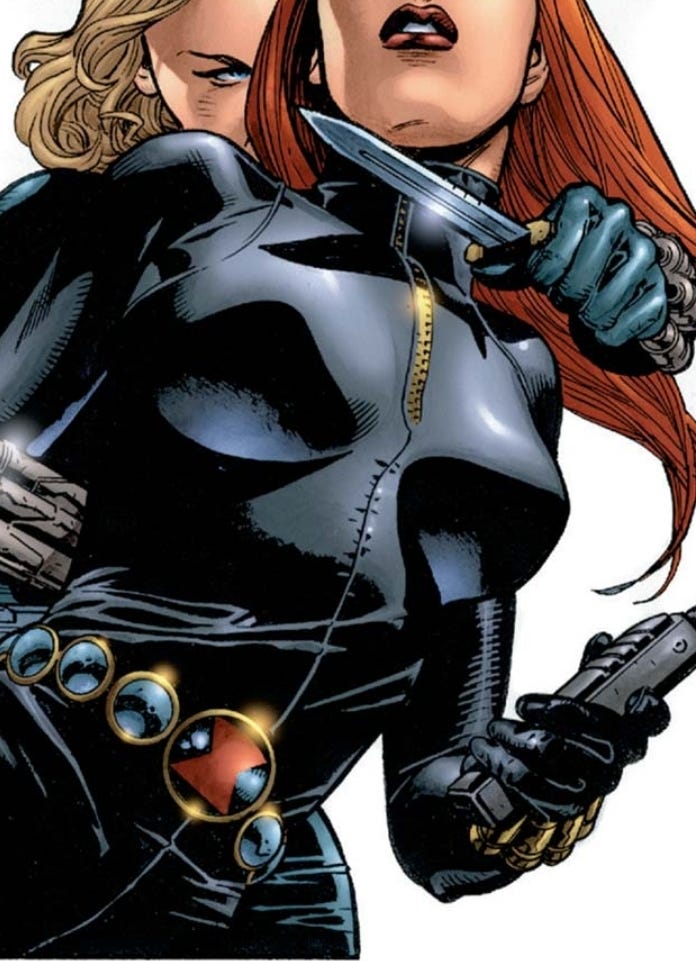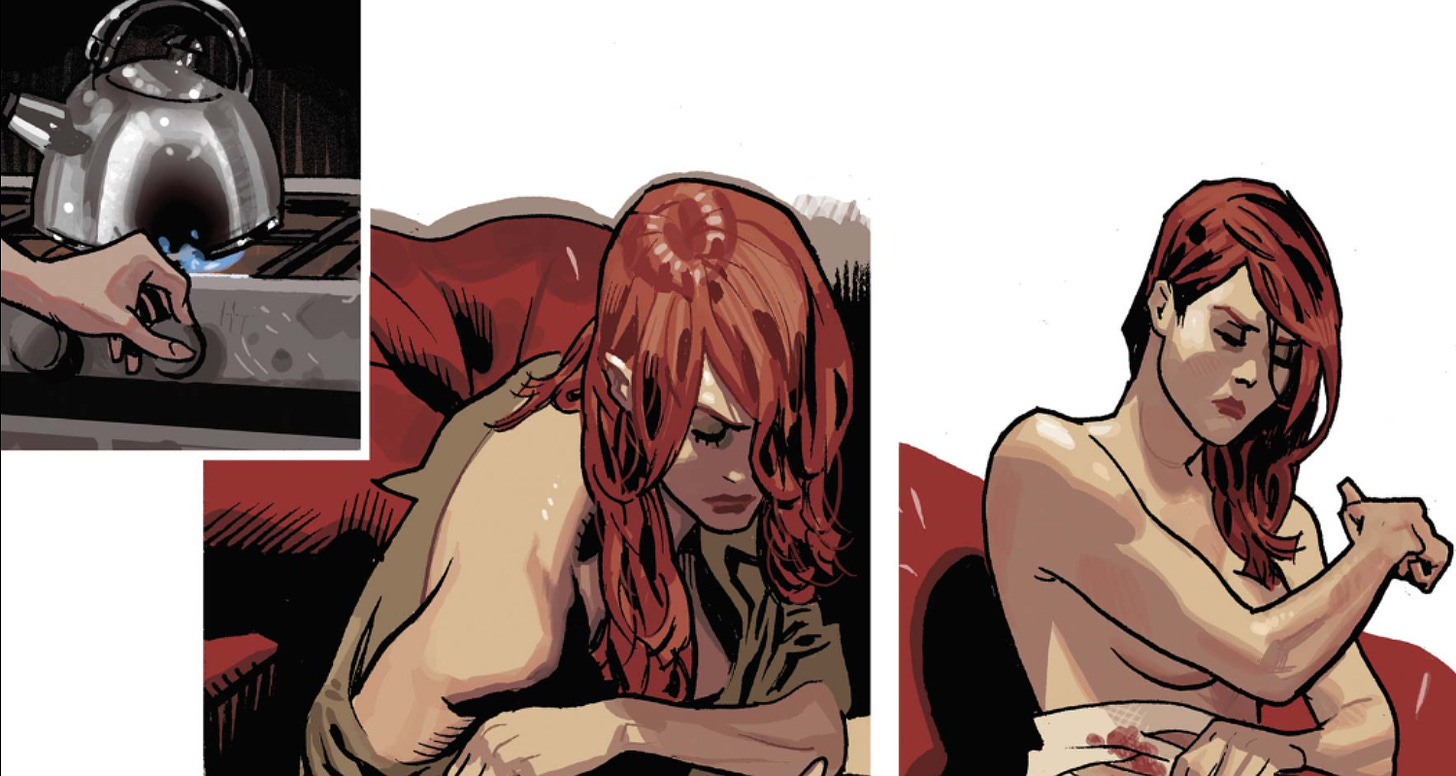Marvel Comics today aren’t sexy.
This is a conscious attempt on part of the company. Marvel NOW! kicked in in tandem with and response to an increasing online call for better representation in comics in the 2010s. It de-emphasized sexuality and put an increased focus on “strong female characterization” as a comics brand. Heroes like Captain Marvel and Ms. Marvel led the charge, and bold experiments like A-Force were pushed through. She-Hulk even got a run that didn’t feel like a horny Spider-Man fanboy wrote it, and Elektra got a tremendous solo series. It was hard – as a socially aware liberal college lad – to find much to fault with the trajectory of the company.
You have to remember that at the time, “sex = right-wing” and “sensible clothes = left-wing.” It feels impossible to explain now, but essentially, the long-standing rampant sexualization and eroticization of female characters in comics came home to roost in virtually every online comics circle. A lot of readers were tired of their only heroines being in skintight bodysuits and posed at improbable angles. It was a fair response, but also one Marvel was entirely too eager to meet in hopes of garnering new readership and (most importantly) synergizing with the cuddly positivity of the Disney brand. It’s led to a company that feels downright puratanical at times next to the brazen horny queerness found in DC.
What does this have to with Natasha ? Everything.
Weaving Natasha’s Web (Conway and the early years)
Black Widow first appeared as a KGB spy in Tales of Suspense. She’s mostly an antagonistic figure who – along with Hawkeye – foils the Avengers until she gets an axe to grind against Mother Russia and defects to America. She was passed along as a femme fatale sometimes ally, sometimes enemy between various books before she eventually found a defining run in Gerry Conway’s Daredevil. Conway was the most responsible – in my opinion – for pushing Natasha’s character towards something we recogonize. He found ample chemistry between the two characters, and even as she was written out by editorial, Conway’s mark on the character was permanent.
Widow didn’t get her first solo outing until 1983. Published across three issues in Marvel Fanfare, ‘Web of Intrigue’ centered Natasha in a sexy bout of espionage neo-noir. Throughout the limited series Natasha slinks around in cheesecake states of undress and escapes devious kidnapping attempts from costumed baddies. Because we weren’t fully into the ‘80s – let alone the ‘90s – Marvel could only take the sexual aspects of the story so far. But the quasi-bondage and power struggle scenarios Widow finds herself in are important here, because they would come to be key hallmarks of the character. It’s a good limited series, at any rate, and gives some compelling if overwrought backstory to the underutilized character.
(It also introduces Snapdragon. Snapdragon is cool. Marvel, bring back Snapdragon.)
But where Widow really takes off is the 1990 graphic novel The Black Widow: The Coldest War. This hard-hitting espionage thriller from Conway and artist George Freeman is a stiff shot in the arm of stylized violence and eroticized torture. Widow is bound, cuffed, slapped, suspended, spit on, and verbally degraded at key narrative crux points. These sequences are interspersed with her lethal derring-do and murky, ambiguous political diatribes between moments of standalone character growth. This goes on – for a time – to define how Black Widow stories are written. Widow is introduced, a crisis is brought to the table, she does some cool spy stuff, and she gets captured.
Noticed I said, “captured.” To frame Widow as a damsel, to lampshade this story with an uncomplicated catch-all like “damseling,” is to misunderstand what makes this character appealing. Black Widow is the unrapeable woman. You can do about a dozen rape-coded things to her, tie her up six ways to sunday, and verbally degrade her until your voice is hoarse. She won’t break and she won’t bend. You can see the DNA of this dynamic in porn comics that then posit, “what if a woman bent and broke and it was super hot?” Elements of this story walk readers right up to that line, invite that suggestion, makes it feel dirty. Then Natasha slices someone’s windpipe and everything’s fine.
As somebody who has a complicated relationship with my own pain-based sexual desires, this stuff resonates. Last night, I read a porn comic where a rich girl abused her butlers ruthlessly. Then they drugged her, raped her, and blackmailed her with the pictures. After breaking her in and repeatedly forcing her sexual servitude, the butlers then make her into their slave completely when her parents die in a plane crash and their company goes under. It’s bleak and ugly fantasy with no silver linings that made me kind of weird cumming to.
But that’s sort of the point of this kind of porn. Regardless of who’s making it – a bleeding heart feminist or a craven misogynist – the erotic element of rape fantasies is the grimy feeling itself. Something that you probably don’t want to happen to you or your friend, but in the context it’s being presented, it’s hot. Sometimes, people can’t divorce the fantasy and let those fantasies get them in all sorts of abusive situations. I know I have. But it’s a fantasy for a reason – confrontational and ugly ideas with raw sexual passion that forces you to reckon with the limits of your own desire.
(You can read more about my relationship with rape fantasies as an assault survivor here.)
Applied to Coldest War, the inverted dynamic gives violent catharsis as opposed to erotic catharsis. Natasha is never stripped and forced to suck a guy’s dick in-panel. (I’m not sure I want to see that.) The erotic aspects, then, take place purely in the torture. The slapping, bondage, and spitting – the power struggle itself – is the core tension readers are meant to feel. We’re meant to not only feel bad for what’s happening to Natasha, but want her to get out of it – not for a man to save her. Conway does a great job of writing this sort of edgy content while never failing to humanize Natasha. He grounds her as a strong, detached, and deeply hurt agent forced to navigate complicated geopolitical struggles without superpowers.
This incarnation of Natasha would team up with Punisher and Daredevil for two more graphic novel adventures before she became roster filler for most of the 90s.
Natasha Gets ‘Knight’ed (Grayson and Rucka)
There are few comics I love as much as Natasha’s solo adventures between 1999 and 2009. For ten years, she was a free agent writers could recruit for their own small-scale espionage adventures.
The first of these was Devin Grayson’s tremendous Marvel Knights limited. Grayson didn’t dial back the aforementioned erotic violence, but instead found new ways to contexualize it. She was the first woman to ever work on the character solo, and much of Natasha’s psychology was defined by how much lived experience the writer put into it. Grayson has been very open about her struggles with depression and trauma, which you see come through in how she writes her “strong” female characters. That is to say: she puts a lot of lived vulnerability, fear, and instability onto Widow. She interrogates what the underpinnings of a character who gets put through what Natasha does might be; gives room for trauma to air and pain to sting. She’s my favorite writer to touch the character for this reason.
Grayson also birthed Yelena – Widow’s ‘little sister’ – into the canon. She was taken on her own erotic violent adventure in Black Widow: Pale Little Spider, a Greg Rucka story so flagrantly sexual, violent, and ‘icky’ that Marvel has notably kept it off their Infinite app. Every other Natasha and Yelena story is accounted for – as far as I can tell – so this feels like a deliberate choice. To read it at a reasonable price, I had to dig around through some local stacks. The books themselves feel like artifacts – extremely fetishistic Greg Land covers emblazoned with Marvel’s gawdy 9/11 memorial banner.
(If it’s on the app and buried somewhere, please let me know. It’s not organized very well!)
Pale Little Spider follows Yelena as she’s led into a seedy underground world of sex dungeons, pain play, and assassinations. Dominatrixes tease and fluster the protagonist throughout, and the pages are loaded with graphic depictions of sexual sadism laced with extremely suggestive dialogue. It’s a level of off-color content one might expect from an average isekai manga, but not a Marvel comic tied to a character who’s been played by Florence Pugh and been plastered on kids’ clothes. All of this serves to further Yelena’s development, however – unearthing, challenging, and understanding her own psychoses partially via exposure to BDSM.
Both Grayson and Rucka take the Sisters Widow to these extreme places to dig up deeper truths about misogyny and its impact on even the strongest women. Grayson earnestly reckons with the ugly reality of Yelena and Widow’s place as disposable, killable tools meant to be raped and murdered by the enemy if they jeopardize the mission. It gives Natasha a gleeful, fighting streak – the kind of character that smiles and asks for more when the enemy beats her because this, too, is part of her plan. To give in just a little. To take just the right amount of punishment. To toe the line until she can turn the tables. Further, Grayson gives Natasha a female character that can finally match wits and pain with her.
Rucka, meanwhile, uses these ideas as jumping off points. Aside from Pale Little Spider, Rucka took the helm of both characters in a 2001 run that saw them reliving a particularly fucked-up redo of Face/Off. With both stories, the writer explored that “give” – the aspects of the characters that thrive on taking abuse in order to fight against it. He also probed the rivalry between both sisters using the face swap macguffin, which allows for some dynamite characterization that draws a distinct line between Natasha and Yelena while also coding them with some taboo sapphic tension. It’s all very good stuff.
In these runs, sex and sexualization are not only asethetic trappings – they’re intergral to the plot, the narrative, and all of the actors within. To take the sexual elements from these stories would be to rob them of the essence that makes them still have so much bite. The same goes for Widow’s last major pre-Disney arc.
Assassinate The Patriarchy (Richard K. Morgan’s Last Stand)
My other favorite run of Black Widow is – without hesitation – Richard K. Morgan’s. Every single book he did of the character is laced with incindiery politics and pitch black perspectives. It’s a bleak comic about maintaining hope when the world seems stacked against not only you, but against your sex.
The central story of his first mini-series – ‘Right To A Life’ – sees a former Widow assassinated while protesting for women’s right to choose. It kicks off a harrowing narrative that interrogates Natasha’s upbringing in the Red Room, and how a cosmetics company is involved in a grand scale plot to sublimate women via pheromones. In a climactic scene, Natasha gets savagely beaten by the patriarchal mastermind – to a point of near-defeat. But at the zero hour, she reveals it was a ploy to get her nose broken and render the pheromones useless. Evil is punished and women are saved.
Or are they? Morgan offers no comfortable or easy conclusions, like Rucka and Grayson. He trades in very obvious subtext to ellicit deeper thoughts and conversations about the nature of patriarchy. This subtext is centered around the mind control and subserviance of Natasha, often codified in a very graphic and overtly sexualized way. Being the mid-00s, spicy torture sequences were all the rage across all American media, and these partly feel like a product of their time. But beyond that, they serve as a useful tool to empower Widow, code torture as evil, and criticize the misogynist standards put on women by the beauty industrial complex.
Morgan followed this run with The Things They Say About Her, a slam-bang espionage chase that pits Natasha against all of her former allies. It reconciles her place as a secret agent in an increasingly politicized climate, and her inability to operate outside the superhero space during the Registration Act era. It’s a less revelatory arc, but nevertheless important development for Natasha who – eventually – resigns to checking herself out of the rat race and going off the map. This is the ultimate understanding and reconciliation of who the character is, to me – an outsider, a rogue, a traumatized woman that can kill any man with her pinkie. She may never fully fit into the Avengers, or have a place in a world of gods and monsters. But she will always be able to play any side, forge any path.
So of course, Marvel reversed all of this.
Spider Exterminators (Post-Disney)
Black Widow’s role in Marvel following their Disney buyout has been mostly dire. To anticipate her role in Iron Man 2, the ill-conceived 2009 Deadly Origin limited series was put together. The less said about this contradictory and unnecessary attempt to rectify The Canon™, the better. Overstuffed with cameos, self-knowing references, and a limp central conflict, the series sputters to an unsatisfying close and leaves more questions about Natasha than answers. It’s non-essential reading.
But it’s the start of a trend, too. Widow books from this point on de-emphasized sexiness, sanded down the violence, and nixed the tilltiating appeal of watching somebody struggle against rope or chain. Natasha becomes a sexless killing machine who’s in a dozen half-relationships with a handful of superheroes. Marjorie Liu’s run is the primary perpetrator of this, which I hate to say as a big fan of the writer. Her 2011 run, however, is a messy and scattershot bit of shipping fan fiction with some ill-advised directions for the character. It leans too heavy on her relationships to Daredevil, Iron Man, Hawkeye, Wolverine, et al, to ever feel like it’s truly her own story. This becomes a problem in the MCU until her solo movie, too – passed around between the male characters as her male co-stars make crass jokes about her being a “whore.”
The first half of the 2010s brought some of the worst Widow writing yet to the table, however. Nathan Edmonson’s 2014 series is something of a travesty. While he brings some compelling heft to the table in how he depicts Natasha’s isolated and untrusting life, Edmonson undercuts early promise to settle in a boring and predictable place by the end of it all. The back half of his series sees Natasha rebuke further S.H.I.E.L.D. missions and abandon her life as a secret agent, instead deciding that she’s happier being a member of the Avengers after all.
While Kelly Thompson’s dynamite 2020 run – perhaps her best ongoing to date – did some damage control, it still couldn’t fix what had been so utterly broken about Natasha: her identity. The most vile, chauvanistic men she faced weren’t as effective at brainwashing Black Widow as Marvel was. Important aspects of her personality, her characterization, and the subject matter her books traded in were sanded down for mainstream appeal. Because you could buy Black Widow on a t-shirt at Wal-Mart, a writer and artist could no longer have a man stomp on her and call her worthless. Childhood heroes can’t be sexual sadism fantasies — that’s un-American! And most importantly — it’s un-Disney.
But to take that aspect away from Widow is to take away – to me – the most important part of her identity. You can’t center a redhead bombshell in a skintight bodysuit who sneaks into dangerous places to do lethal things to gross men and not play with sex. Sorry! Natasha is an inherently sexual character. Her relationship to pain and her ability to withstand is not only an asset, it’s a valuable tool in her playbook. She gives not only villains, but readers the fantasy of a helpless woman in distress only to subvert it. It’s the same type of greasy grimy table-turning that makes films like I Spit On Your Grave so affecting. Like Jennifer Hill, Black Widow is a hero for her ability to take abuse, live through it, and dish it out in greater measure.
To sand the Widows down in favor of making them the same uni-girlboss Marvel has favored lately feels like a robbery. What makes Natasha and Yelena so compelling is that vulnerability – that ability to suffer and live through it. They’re not confident military women like Carol Danvers, smart but brash lawyers like Jennifer Walters, or starry-eye heroines like Kamala Khan. Like most of us, they’re just real people with weaknesses, insecurities, emotional and physical scars.
Further – as somebody who’s very into being hurt to achieve catharsis and pleasure – these stories give me fantasies to play off of. Confidence that my desire to be hurt isn’t a weakness, but a challenge – a test to be put through. The feeling that my own Red Room, my own torture sequences aren’t moments of weakness in my head, but things I lived through to be stronger.
And if I can live through that, I want to be slapped, choked, and bound. Just to prove that I’ll live. That I can come back as more than some rich asshole’s plaything.
That’s empowerment, to me – and I don’t think I’m alone in that.
This Week’s Brew
-- I threatened to write about comics, didn’t I? Nobody told me to, but I wanted to. ‘Nuff said.
-- Naturally, I watched some giallo over the past week – including a double feature of Martino murder marathons. I finally checked Torso off my list; pretty gristly and just plain pretty. The Scorpion With Two Tails impressed me less, but it was still a twisty and compelling thrill ride.
-- Also tuned into The Perfume of the Lady in Black, a distressing, moody psychological thriller with an upsetting conclusion. Ditto for The Killer Is Still Among Us, a bleak slasher that nails the moody psycho-sexual angst piece It Follows tried for.
-- I watched so many DCAU films last week that I needed a little break. However, aside from Gotham By Gaslight, I’ve watched: Soul of the Dragon, The Flashpoint Paradox, Batman & Harley Quinn, Bad Blood, and both the Long Halloween flicks.
-- (pain) slut, alas, did not find her home at the compilation I submitted her to. It was short-listed, and the editors were very kind and enjoyed the story, but ultimately it wasn’t the best fit. However, I turned around and submitted it to another lit mag the next day. We’ll see if they love her as much as I do.
-- Podcasting plans are still underway. The current state of our show will be a structured watch-through cast – reliable format and there are plenty of series, shows, et al, we want to dig into. Right now, we’ve floated Ultra Q or Kamen Rider as potential first watches. More soon.
-- I’ve got a new article coming at Paste. It’s about Hello Kitty. That’s all I’ll say for now!








